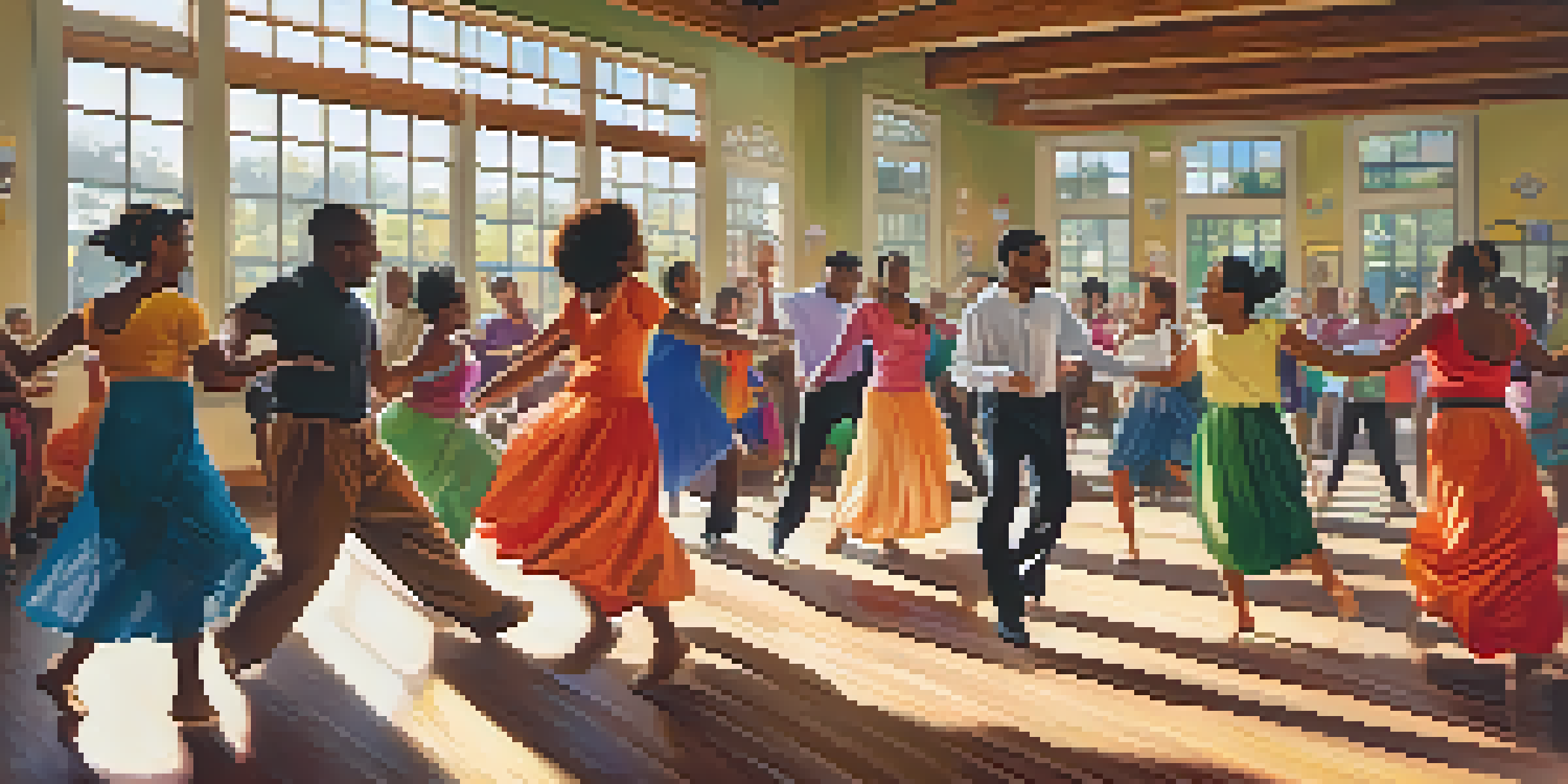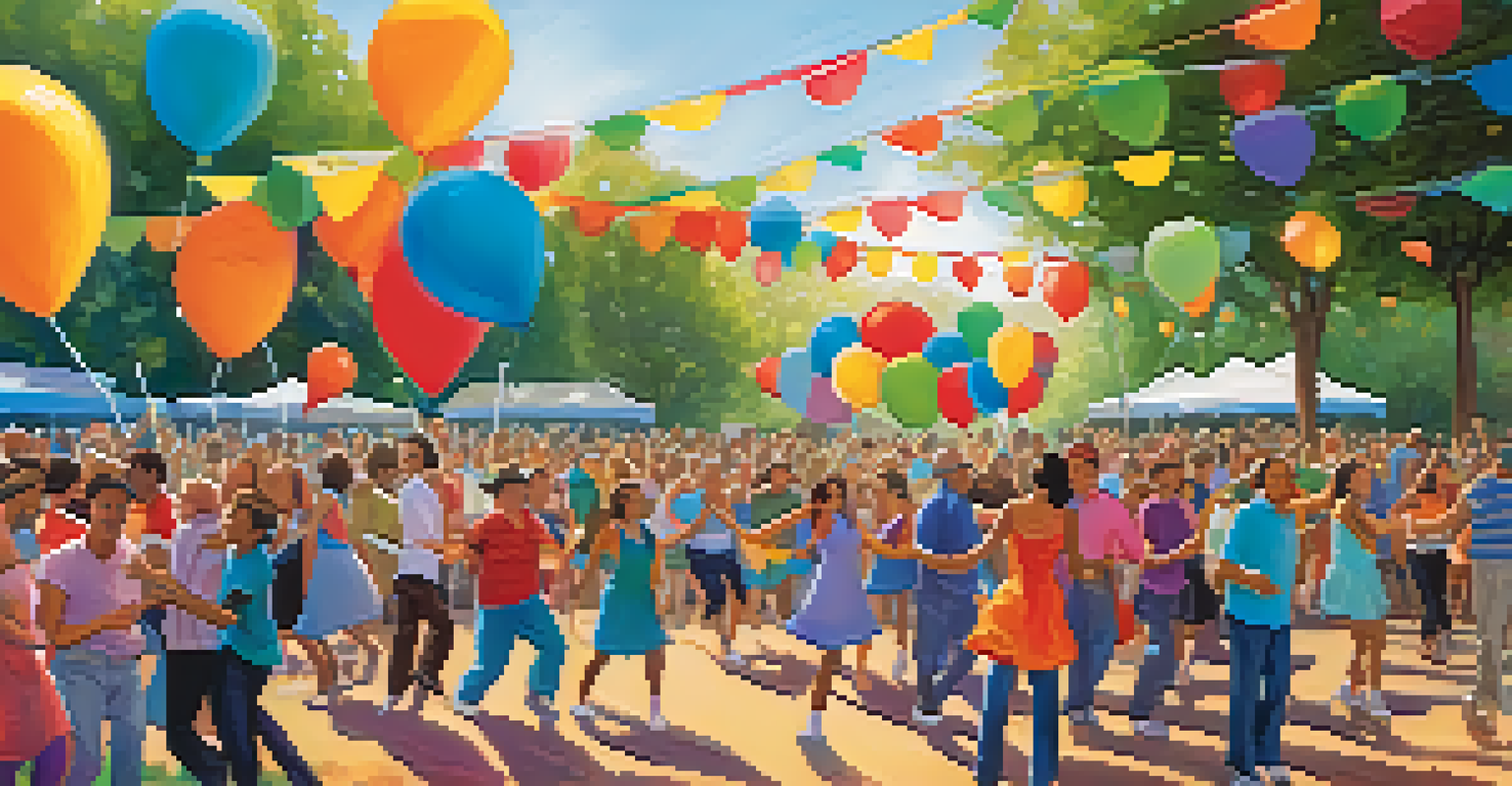The Role of Dance in Mental Health and Loneliness Relief

Understanding the Connection Between Dance and Mental Health
Dance is not just a form of artistic expression; it’s also a powerful tool for mental well-being. Engaging in dance can elevate your mood, reduce anxiety, and even combat depression. This physical activity stimulates the release of endorphins, often referred to as 'feel-good' hormones, which can foster a sense of happiness and relaxation.
Dance is the hidden language of the soul.
Moreover, dance encourages mindfulness—being present in the moment. When you're focused on the rhythm of the music and the movements of your body, you can temporarily escape from worries and stressors, creating a mental space that promotes healing. This combination of physical activity and mental focus can be incredibly therapeutic.
In a world where mental health issues are becoming increasingly prevalent, incorporating dance into one’s routine may serve as an accessible and enjoyable coping mechanism. Whether you’re taking a class or dancing in your living room, the benefits are clear: dance can be a joyful antidote to mental distress.
How Dance Fosters Social Connections and Reduces Loneliness
One of the most beautiful aspects of dance is its ability to bring people together. Whether it’s in a dance class, social gathering, or community event, the shared experience of moving to music can create bonds that diminish feelings of loneliness. This social interaction is crucial, as humans are inherently social beings who thrive on connection.

When you dance with others, you’re not just sharing the physical space; you’re also sharing emotions, laughter, and a sense of belonging. These interactions can lead to new friendships and support systems that help combat isolation. Plus, the joy of dancing together can create lasting memories that fortify these connections.
Dance Enhances Mental Well-Being
Engaging in dance elevates mood, reduces anxiety, and promotes mindfulness, making it a beneficial practice for mental health.
In essence, dance provides a unique platform for social engagement. It invites individuals to step out of their comfort zones, meet new people, and create a sense of community, all while enjoying the therapeutic benefits that come with movement.
The Therapeutic Benefits of Dance Movement Therapy
Dance Movement Therapy (DMT) is a professional practice that harnesses the power of dance to promote emotional and physical healing. By focusing on the body’s movements, DMT encourages individuals to express their feelings and experiences non-verbally, which can be particularly beneficial for those who struggle to articulate their emotions.
To dance is to be out of yourself. Larger, more beautiful, more powerful. You are not just in the body; you are the body.
Through guided dance sessions, participants can explore their feelings in a safe and supportive environment. This form of therapy can help reduce symptoms of anxiety and depression, and even improve self-esteem. The freedom of movement allows for personal exploration and can facilitate profound emotional release.
DMT is not just for those with mental health issues; it can benefit anyone looking to improve their emotional and physical well-being. It emphasizes the mind-body connection, reminding us that our physical state often reflects our mental state, reinforcing the importance of holistic approaches to health.
Dance as a Form of Self-Expression and Empowerment
For many, dance serves as a powerful form of self-expression, allowing individuals to communicate feelings that words cannot capture. This unique outlet can be especially liberating, as it encourages creativity and individuality. When people dance, they often feel a sense of freedom and empowerment that can translate into greater self-confidence.
Moreover, dance can be a way to reclaim one’s narrative, especially for those who have experienced trauma or hardship. By expressing their stories through movement, individuals can process their emotions and experiences in a constructive way. This act of self-expression can help individuals feel more in control of their lives.
Dance Builds Social Connections
Participating in dance activities fosters social bonds and reduces feelings of loneliness by creating shared experiences.
Ultimately, the transformative power of dance lies in its ability to foster a sense of agency and identity. Whether through structured classes or spontaneous movements in a living room, dance invites people to celebrate who they are and encourages self-acceptance.
The Role of Music in Enhancing Dance and Emotional Health
Music plays an integral role in the experience of dance, serving as both a backdrop and a catalyst for movement. The rhythm and melody of a song can evoke various emotions, enhancing the overall experience of dancing. This relationship between music and dance can amplify feelings of joy, nostalgia, or even sadness, allowing individuals to connect deeply with their emotions.
Listening to music while dancing can also stimulate brain activity, leading to improved cognitive functions and emotional processing. Research has shown that specific types of music can even help reduce stress levels and promote relaxation, making it easier to embrace the benefits of dance.
Thus, the combination of music and dance creates a synergy that enriches emotional well-being. It allows individuals to escape from everyday stresses and fosters a deeper connection to their feelings, ultimately enhancing the mental health benefits of dance.
Accessible Dance Forms for Everyone: No Experience Needed
One of the most appealing aspects of dance is that it can be accessible to everyone, regardless of age, skill level, or background. You don’t need to be a trained dancer to reap the mental health benefits that come from moving to music. Simple forms of dance, like freestyle or Zumba, can be easily incorporated into daily routines, making it easy for anyone to participate.
Additionally, many community centers and online platforms offer free or low-cost dance classes, ensuring that everyone has the opportunity to engage in this uplifting activity. This inclusivity is vital, as it allows individuals from various walks of life to come together and connect through the universal language of dance.
Dance Movement Therapy Benefits All
Dance Movement Therapy promotes emotional expression and healing, benefiting anyone seeking to improve their mental and physical well-being.
Ultimately, the essence of dance lies not in perfection but in participation. It’s about enjoying the movement, expressing oneself, and connecting with others—elements that can significantly enhance mental health and relieve feelings of loneliness.
Creating a Dance Routine for Mental Wellness
Establishing a dance routine can be a fantastic way to integrate movement into your life while prioritizing mental well-being. Start by setting aside a few minutes each day to dance to your favorite songs. This doesn’t have to be complicated; even a simple sway or freestyle can do wonders for your mood.
As you become more comfortable, consider exploring different styles of dance, such as ballet, hip-hop, or salsa. Each style offers unique benefits and can keep your routine fresh and exciting. Joining classes or online sessions can also enhance your experience, as you’ll have the opportunity to learn new moves and connect with others.

Remember, the goal is to have fun and enjoy the process. By making dance a regular part of your life, you can create a positive outlet for stress relief, self-expression, and connection, ultimately contributing to improved mental health and decreased feelings of loneliness.